This Is How People Cooked & Ate Hamburgers In The 1950s
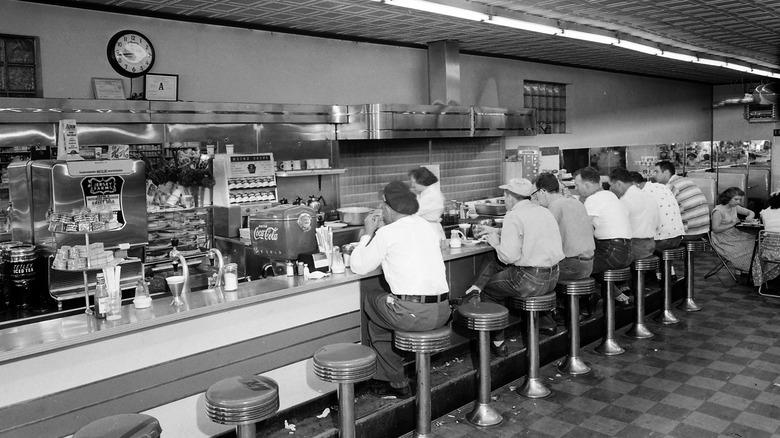
It's an image easily conjured up in the minds of Americans -- the quintessential 1950s diner. There's a checkered floor, a jukebox, stools and tables alike, and throngs of customers in poodle skirts and letterman jackets. But what stands to finish off the picture-perfect scene in your mind's eye? Why, a juicy, retro hamburger sitting on the counter, of course -- the pinnacle of 1950s fast food perfection.
But little did you know, that hamburger you're imagining was quite different from the burger you're likely used to seeing in modern-day restaurants. Even the way you cook your version of the dish at home likely varies from how it was done in the middle of the 20th century. Burgers have evolved over the years, and in the '50s, they were just beginning to hit their stride. In a sense, the hamburgers of yesterday paved the way for the hamburgers of today.
But how exactly did these original takes differ in aspects like taste, texture, and makeup from that of the more modern variants, you might wonder? We peeled back all the more recent burger innovations to find out. From drive-ins to sticks of butter to some rather interesting kitchen appliances, here's how people cooked and ate hamburgers in the 1950s.
Read more: Fast Food Hamburgers Ranked Worst To Best
They Enjoyed Them At Drive-In Restaurants
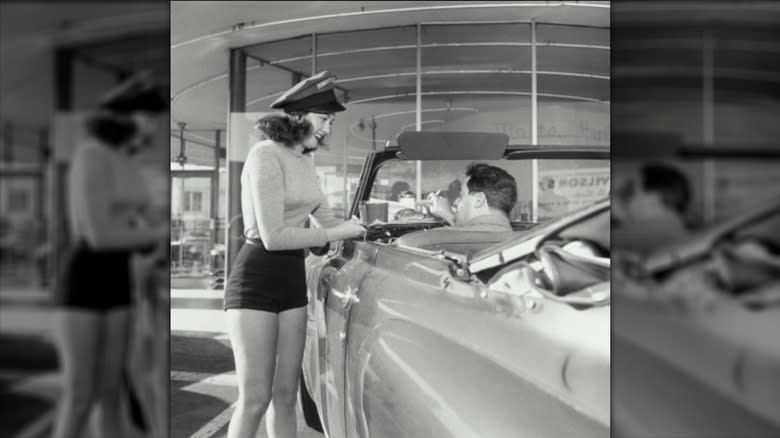
The 1950s are considered the American burger boom, a time in which the popularity of hamburgers took off for good in the United States. This could certainly be due, in part, to the jubilance of a post-war population ready to live life to the fullest by chowing down on delicious beef sandwiches ... but it could also be attributed to the explosion of the fast food drive-in.
Before the commonplace drive-thrus of today, there were drive-ins -- a concept that involved parking in a lot, placing an order, and having a carhop bring the food to the window. Brought on by the mass availability of automobiles, drive-ins hit their peak after the end of the Second World War. And drive-ins, of course, were nearly synonymous with hamburgers.
Both of the eventual burger chain powerhouses McDonald's and In-N-Out had opened their doors by the end of the 1940s. Burger King joined the party in '54, and Wendy's came along in the 1960s. Suffice it to say that millions of hungry Americans were pulling into the lots -- or, more specifically, the drive-ins -- of steadily growing burger chain locations across the country in the '50s to get their fix.
They Cooked Them In Their Homes Too
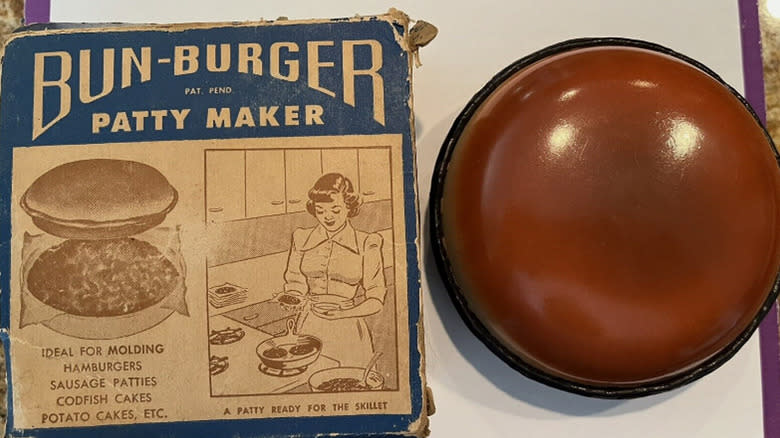
It wasn't only fast food restaurants and diners that were serving up hamburgers in the 1950s -- home cooks were doing so in their very own kitchens. Home burger recipes in the cookbooks of the decade were simple, often calling for nothing but ground chuck, butter, onions, and a pinch of salt or pepper -- leaving out many of the typical additives and binders like eggs or breadcrumbs that we tend to use in modern recipes. Home cooks often placed caramelized onions on top of patties directly as they cooked, and butter or margarine was heated in the frying pan before adding the meat.
But it wasn't only frying pans that helped home chefs craft the perfect hamburgers at home. If shaping the patties themselves caused problems, then one kitchen accessory in particular, the Bun-Burger Patty Maker, facilitated the process. Smartly shaped like a burger-in-a-bun, the device closed like a sandwich around the ground meat, forming a perfect circle that could then be placed in a skillet. Anyone who has ever experienced the frustration of a homemade burger falling apart during the shaping process might be able to see the benefit of this clever little invention.
The Meat Was Mostly Fresh
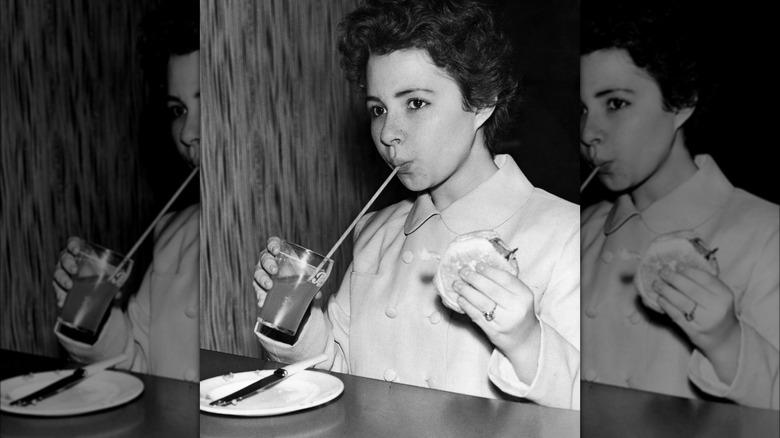
It was the burger boom of the '50s that led to the eventual implementation of feedlots and the mass production of corn-fed cows to keep up with demand. After this meat-centric decade, livestock production was never the same again. However, at the very start of the '50s, much of the beef used to form hamburgers was likely still grass-fed and generally pretty fresh. Rather than having frozen patties shipped in, restaurants by and large used never-frozen meat. "In the '50s, it went from the cow to the grill!" reminisced a nostalgic user on Reddit.
They aren't kidding. The world's first burger chain, White Castle, actually started by grounding meat on-site to prove the freshness and purity of its patties to consumers -- a move which proved to be paramount in the early growth of the dish's popularity. The Tampa Bay Times also reported that the world's current leading fast food chain, McDonald's, started with fresh patties as it hit its stride in the '50s, moving onto a frozen product over time as the franchise grew larger. Interestingly, McDonald's switched back to fresh beef for some of its popular burger products in 2018. Taking a note from the past, perhaps?
The Patties Were Typically Fried In Lard Or Butter
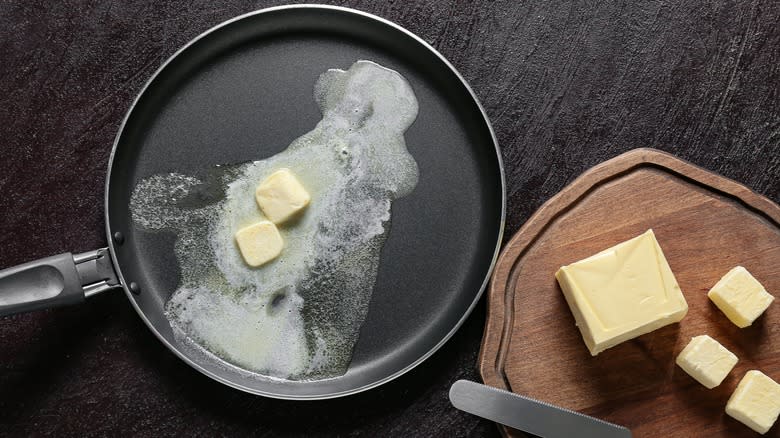
Meat was king in the 1950s. Maybe there was a veggie or a little plate of potatoes to be seen on the side of all the retro illustrated dinner ads, but the star of the majority of plates in the mid-20th century seemed to be a slab of steak, a meatloaf, or a juicy burger. As much as red meat can be an important part of a healthy diet, too much can play a role in elevated cholesterol. Though obesity rates were far lower in the 1950s than they are today, there were still some cooking techniques that could have contributed to what some might call animal fat overload.
One of these was the tendency to lather the pan or grill in butter or lard before frying an already-fatty steak or burger ... or, really, before frying anything at all. "Fry either in lard or butter (I'm not sure which, but it ain't low-fat)," recalled a Reddit user, discussing burgers from the '50s. Another individual with personal experience -- and a registered dietitian -- said in an article for My Journal Courier: "When I was growing up, we kept a tin of bacon grease on the stove to season vegetables and fry meats. There is no such tin in my kitchen today."
They Smashed The Patties Thin On A Flat Grill, Creating A Crust
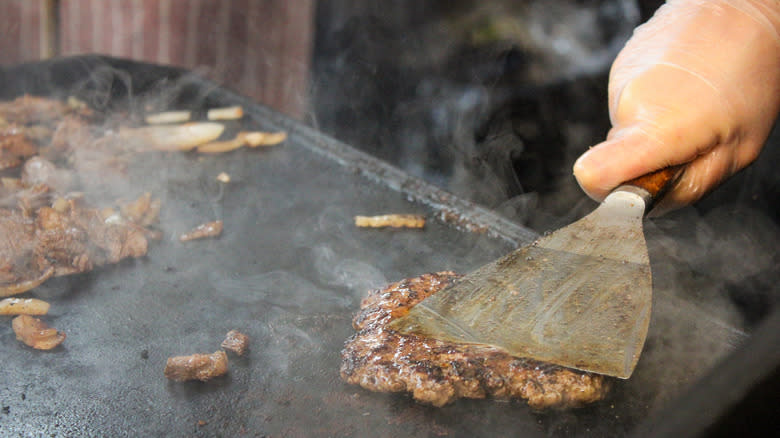
Many modern-day burger fans may be used to chowing down on a thick patty slab, but in the 1950s, this was not the way. At the time, it was much more typical to create a thinner patty with a hint of an outer crust along the edges -- a style that is very often referred to as a "smashburger" in the modern era.
In a YouTube video by burger expert George Motz called "To Smash Or Not To Smash?", he explains the reasoning behind the technique. During the burger boom of the mid-20th century, patties needed to be prepared as quickly as possible for the throngs of lined-up consumers. There was simply no time to prepare a big thick steak burger every time. Thinner patties cooked much quicker, and additionally, maintained their moistness and flavor.
One modern-day restaurant called Hackensack 1950s Burger, which advertises itself as an authentic American 1950s-style diner, posted a video in 2021 displaying its classic technique of creating the traditional mid-20th-century smashburger. A rounded ball of beef is first placed on the steaming griddle then pressed flat with two large metal spatulas just before the toppings are added -- in the end, the most perfect, crisp-looking edges are displayed. If this is how all burgers back in the good old days looked, then we're going to need a time machine, stat.
Onions Were Added To The Meat While It Cooked
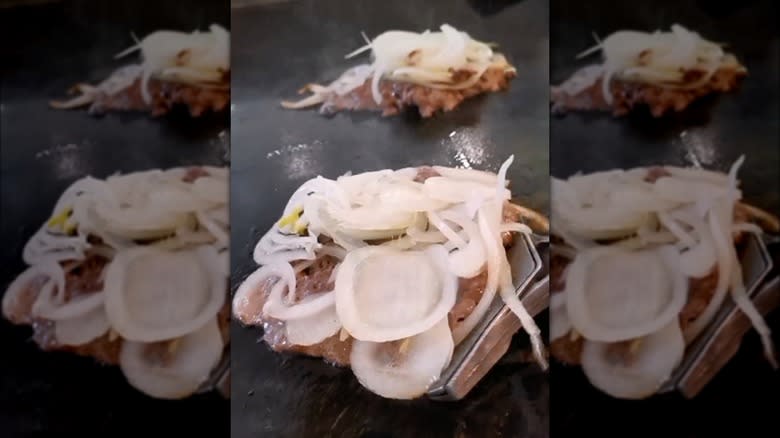
Just after pressing the round ball of beef flat on the griddle to create that perfect, traditional '50s-style smashed burger patty, it was typical for toppings to be added while the meat was still cooking -- namely, sliced onion. Adding onions directly to burger patties as they cooked was the undisputed culinary trend in the mid-20th century, from fast food restaurants to mom-and-pop diners to home kitchens alike. "Raw, or near raw onions on a burger is a more modern notion, and any grill in the '50s would have had onions on it," speculated a user on Reddit. "Even if you didn't have them on your burger, they would season the grill and you'd get some of the taste anyway."
While it's unclear exactly what started this trend, we can almost certainly lay some of the credit at the feet of White Castle. The chain is attributed with helping to popularize the burger in America, publicly claiming the dish's numerous health benefits, and creating the Original Slider in 1921 using a technique that involved poking holes in the meat and placing it on the grill atop piles of diced onions. It seems likely that White Castle could have aided in paving the way for the widely-used onion trend -- and, considering how much flavor a searing onion imparts on a patty, it was a great move.
Mustard, Ketchup, And Pickles Were Must-Have Condiments
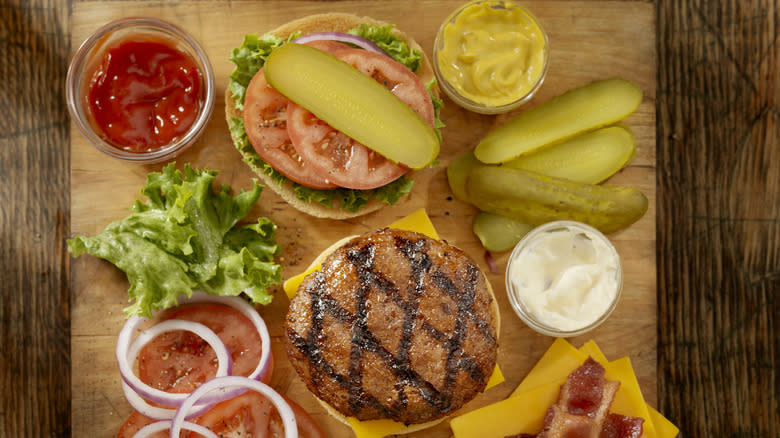
In the year 2024, it seems like everything edible under the sun has been placed atop a burger. Pineapple? Sure! Peanut butter? Why not! But how did we get to this modern-day level of innovation when it comes to our beef patties? It had to start somewhere, of course, and we'd imagine, due to the dish's sheer popularity alone, that the creative juices began flowing during the golden age of burger consumption.
According to an alleged professional chef discussing the period in history on Quora, typical condiments on a standard burger in the 1950s included traditional options like onions, mustard, ketchup, pickles, and sometimes cheese. But there were also the beginning sparks of innovation to be found in the decade -- people stepping out on a limb and experimenting with new, interesting toppings, as well.
Good Housekeeping released an article in 2015 referencing its magazine issues throughout the years and the various burger toppings it had suggested to readers. The 1940s, it claimed, was the decade in which it began to embellish and give new life to topping ideas. Beginning with the suggestion of a fried egg in 1944, it eventually moved on to flavored butters, chives, olives, horseradish, and even apple slices in the 1950s. How's that for keeping the dinner table interesting?
The Finished Product Was Much More Modest In Size
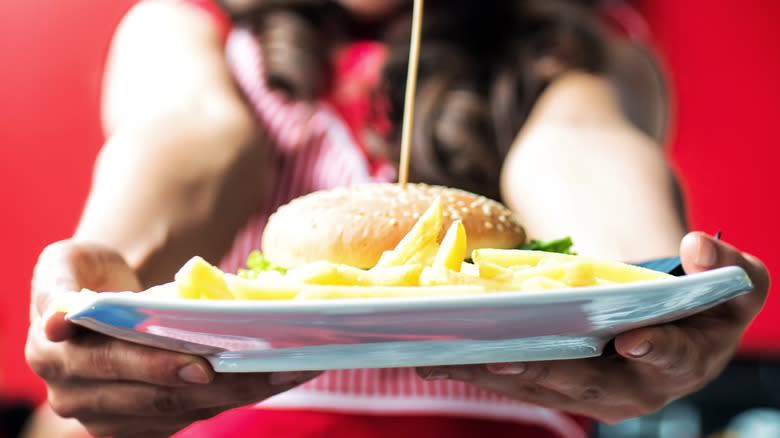
The gargantuan stacked burgers with multiple layers of alternating patties and melted cheese that we are so accustomed to seeing on modern-day menus really is a thing of today. Back in the 1950s, a hamburger or cheeseburger was significantly smaller than the meaty giants of our era -- a third of the size, to be exact.
The Center for Disease Control (CDC) released an infographic displaying the average size of a hamburger in the 1950s. It weighed about 3.9 ounces -- a measly portion compared to the average burger of today, which is a whopping 12 ounces -- and, subsequently, was much less calorie-heavy. Portion sizes from hamburgers to potato sides to soft drinks have also greatly increased ... as have the sizes of the people eating them.
The CDC reported that the average adult is 26 pounds heavier than they were in the '50s, and suggested ordering the small format on modern-day menus -- a size which likely would have equated to a large during the post-World War II era. This, it suggests, may help consumers eating in the 21st century control their portions more adequately when dining out.
They Ate Them With Freshly-Cut Fries And A Milkshake On The Side
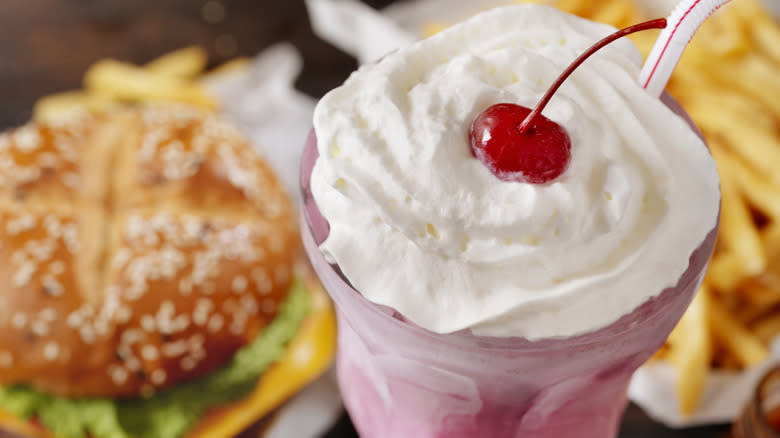
Menus in the middle of the 1900s were simple. It was typical to see nothing but hamburgers, cheeseburgers, fries, and milkshakes listed on the letter board -- and so, fries and milkshakes were what people ordered to accompany their savory burger dish.
While the majority of modern-day fast food eateries use from-frozen fries, back in the 1950s, this was not the case. In fact, quite the opposite: At the start of the decade, restaurants were skeptical about using frozen potatoes. The leading modern-day frozen fry supplier Simplot, which creates the mouthwatering waffle fries for Chick-fil-A, for example, struggled to sell its frozen fry idea to restaurants in the early '50s.
In this decade, potatoes were typically still washed, peeled, and cut daily for hungry consumers -- so your salty side dish was guaranteed to be fresh. Milkshakes, too, were all the rage in the '50s and were made with real soft-serve ice cream, malt, and milk, shaken up in a special milkshake mixing machine that nearly every diner and fast food restaurant was equipped with.
Read the original article on Mashed.

